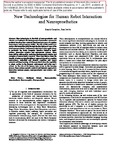Human-Robot Interaction and Neuroprosthetics: A review of new technologies
| dc.contributor.author | Cangelosi, Angelo | |
| dc.contributor.author | Invitto, S | |
| dc.date.accessioned | 2017-08-29T16:21:16Z | |
| dc.date.available | 2017-08-29T16:21:16Z | |
| dc.date.issued | 2017-07 | |
| dc.identifier.issn | 2162-2248 | |
| dc.identifier.issn | 2162-2256 | |
| dc.identifier.uri | http://hdl.handle.net/10026.1/9872 | |
| dc.description.abstract |
New technologies in the field of neuroprosthetics and robotics are leading to the development of innovative commercial products based on user-centered, functional processes of cognitive neuroscience and perceptron studies. The aim of this review is to analyze this innovative path through the description of some of the latest neuroprosthetics and human-robot interaction applications, in particular the brain-computer interface (BCI) linked to haptic systems, interactive robotics, and autonomous systems. These issues will be addressed by analyzing developmental robotics and examples of neurorobotics research. These new devices show the benefits of using an interdisciplinary approach based on cognitive neuroscience, embodied and situated cognition, neural network, and deep learning. All of these products share the capability to adapt, online, to the dynamic environment and to the user's actions. As the role of the human tutor is key in this learning process, these systems permit a natural and dynamic approach to interaction among people, neuroprosthetics, and robotics self-extensions. | |
| dc.format.extent | 24-33 | |
| dc.language.iso | en | |
| dc.publisher | Institute of Electrical and Electronics Engineers (IEEE) | |
| dc.subject | Neurosciences | |
| dc.subject | Clinical Research | |
| dc.subject | Bioengineering | |
| dc.subject | Behavioral and Social Science | |
| dc.subject | Assistive Technology | |
| dc.subject | Mental health | |
| dc.title | Human-Robot Interaction and Neuroprosthetics: A review of new technologies | |
| dc.type | journal-article | |
| dc.type | Review | |
| dc.type | Trade Journal | |
| plymouth.author-url | https://www.webofscience.com/api/gateway?GWVersion=2&SrcApp=PARTNER_APP&SrcAuth=LinksAMR&KeyUT=WOS:000403824700011&DestLinkType=FullRecord&DestApp=ALL_WOS&UsrCustomerID=11bb513d99f797142bcfeffcc58ea008 | |
| plymouth.issue | 3 | |
| plymouth.volume | 6 | |
| plymouth.publication-status | Published | |
| plymouth.journal | IEEE Consumer Electronics Magazine | |
| dc.identifier.doi | 10.1109/mce.2016.2614423 | |
| plymouth.organisational-group | /Plymouth | |
| plymouth.organisational-group | /Plymouth/Faculty of Science and Engineering | |
| plymouth.organisational-group | /Plymouth/Research Groups | |
| plymouth.organisational-group | /Plymouth/Research Groups/Institute of Health and Community | |
| plymouth.organisational-group | /Plymouth/Research Groups/Marine Institute | |
| dc.identifier.eissn | 2162-2256 | |
| dc.rights.embargoperiod | No embargo | |
| rioxxterms.versionofrecord | 10.1109/mce.2016.2614423 | |
| rioxxterms.licenseref.uri | http://www.rioxx.net/licenses/all-rights-reserved | |
| rioxxterms.type | Journal Article/Review |


